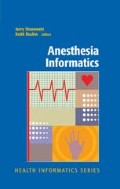The primary motivation, or return on investment (ROI), for purchasing an EMR for most office-based physician practices focuses predominately on the ability to enhance and automate charge capture. In the paper world, a patient would be seen by a physician, who would create notes on paper records. The physician would then typically complete a “superbill”—a fairly standardized form that contains most of the chargeable items for that particular specialty. This superbill would be sent to the front office at checkout and form the basis for the documentation of services rendered, charges generated by the office staff, and the subsequent claim submission to the payer. Unfortunately, in this scenario, the physician filling out the superbill would frequently code or bill for a visit that was not adequately justified from the documentation in the chart. Concomitant with the passage of HIPAA, this miscoding became fraudulent billing, susceptible to fines and penalties. 1 With the advent of EMRs, the selection of charges could be generated by software algorithms based on specific rules that are incorporated into the charge functionality. These sophisticated systems could even “recommend” actions that would enhance the documentation and consequently increase the level of coding for the medical visit. 2, 3 For example, an on-screen alert could indicate that if the physician would simply define the social history, the visit could qualify for an evaluation and management code that would be slightly higher than that coded without the social history. A significant proportion of the ROI cited by vendors of these systems is the ability to accurately capture all charges and potentially enhance revenue generation. Despite the obvious advantage of digitizing the clinical records and the concomitant ability to analyze these data, no business entity would decide to invest in these expensive systems unless they could generate savings, either through reduced expenses or increased revenues.
Access this chapter
Tax calculation will be finalised at checkout
Purchases are for personal use only
Preview
Unable to display preview. Download preview PDF.
References
Shuren AW, Livsey K. Complying with the Health Insurance Portability and Accountability Act. Privacy standards. AAOHN J 2001; 49(11):501–7
Kawamoto K, Houlihan CA, Balas EA, et al. Improving clinical practice using clinical decision support systems: A systematic review of trials to identify features critical to success. Br Med J 2005; 330:765
Vigoda MM, Lubarsky DA. The medicolegal importance of enhancing timeliness of documentation when using an anesthesia information system and the response to automated feedback in an academic practice. Anesth Analg 2006; 103:131–6
Blue Cross & Blue Shield, Medicare Part B Reference Manual, Anesthesia Billing Guide, April 2004
AMA Web site for CPT codes. http://www.ama-assn.org/ama/pub/category/3113.html. Accessed December 19, 2007
National Correct Coding Initiative Policy Manual for Medicare Services. Chicago: American Medical Association, 2005. Chap. 2, Anesthesia Services CPT Codes 00000–09999
American Society of Anesthesiologists, 2007 Crosswalk. Park Ridge, IL: ASA Publications, 2007
Wynn BO, Beckett MK, Hillborne LH, et al. Evaluation of Severity-Adjusted DRG Systems: Interim Report. Santa Monica, CA: Rand, 2007
Averill R, Goldfield N, Hughes J,. What are APR-DRGs? An Introduction to Severity of Illness and Risk of Mortality Adjustment Methodology. Salt Lake City, UT : 3M Health Information Systems, 2003
Health services cost review commission fact sheet on transition to APR-DRG for Maryland hospitals. http://www.hscrc.state.md.us/current_policy_papers/documents/fsr_apr_drg_tran-sition.doc. Accessed December 19, 2007
CMS Payment System Fact Sheet. http://www.cms.hhs.gov/MLNProducts/downloads/ AcutePaymtSysfctsht.pdf. Accessed February 8, 2008
CMS Fact Sheet on FY2008 IPPS Proposed Rule Improving Quality of Hospital Care, released 04/13/07. http://www.cms.hhs.gov/apps/media/press/factsheet.asp?Counter=2119&i ntNumPerPage=10&checkDate=&checkKey=&srchType=1&numDays=3500&srchOpt=0&s rchData=&keywordType=All&chkNewsType=6&intPage=&showAll=&pYear=&year=&des c=&cboOrder=date. Accessed July 2007
Gibby GL, Paulus DA, Sirota DJ, et al. Computerized pre-anesthetic evaluation results in additional abstracted comorbidity diagnoses. J Clin Monit 1997; 13(1):35–41
Stonemetz J, Pham JC, Marino RJ, et al. Effect of concurrent computerized documentation of comorbid conditions on the risk of mortality index. J Clin Outcomes Manage 2007; 14(9):499–503
Stonemetz J. Establishment of an anesthesia consult service. Annual Meeting of the American Society of Anesthesiologists, San Francisco, CA, October 13–17, 2007. Anesthesia 2007; 107:A1871
National Center for Health Statistics. http://www.cdc.gov/nchs/about/otheract/icd9/abticd10.htm. Accessed August 2007
World Health Organization. http://www.who.int/classifications/icd/en. Accessed January 8, 2008
Averill RF, Mullin RL, Steinbeck BA, et al. Development of the ICD-10 Procedure Coding System (ICD-10-PCS). http://ncvhs.hhs.gov/020409p2.pdf. Accessed January 8, 2008
Libicki M, Brahmakulam I. The Costs and Benefits of Moving to the ICD-10 Code Sets. Santa Monica, CA: Rand, 2004.http://www.rand.org/pubs/technical_reports/2004/RAND_TR132. pdf. Accessed January 8, 2008
Medicare ‘Pay For Performance (P4P)’ Initiatives. http://www.cms.hhs.gov/apps/media/press/release.asp?Counter=1343. Accessed January 8, 2008
CMS Physician Quality Reporting Initiative (PQRI). http://www.cms.hhs.gov/pqri/. Accessed January 8, 2008
Bierstein K. Pay for Participation in Medicare's Physician Quality Reporting Initiative. http://www.asahq.org/Newsletters/2007/05-07/pracMgmt05_07.html. Accessed January 8, 2008
Bierstein K. Anesthesia is in the P4P Game. ASA Newsletter, 2006. http://www.asahq.org/Newsletters/2006/12-06/pracMgmt12_06.html. Accessed January 8, 2008
CMS PQRI FAQ page. http://questions.cms.hhs.gov/cgi-bin/cmshhs.cfg/php/enduser/std_adp.php?p_faqid=8451&p_created=1180632624&p_sid=JYI3jsDi&p_ accessibility=0&p_lva=&p_sp=cF9zcmNoPTEmcF9zb3J0X2J5PSZwX2dyaWRzb3J0PS ZwX3Jvd19jbnQ9MTkmcF9wcm9kcz04LDYxLDk0NSw5NjgmcF9jYXRzPSZwX3B2P TQuOTY4JnBfY3Y9JnBfc2VhcmNoX3R5cGU9YW5zd2Vycy5zZWFyY2hfbmwmcF9 wYWdlPTE*&p_li=&p_topview=1. Accessed January 8, 2008
Office of Inspector General. Work Plan: Fiscal Year 2007. Department of Health and Human Services. http://oig.hhs.gov/publications/docs/workplan/2007/Work%20Plan%202007.pdf. Accessed January 8, 2008
Bourdreaux A. Committee on anesthesia care team: A committee for all. ASA Newsletter, 2005. http://www.asahq.org/Newsletters/2005/03-05/boudreaux03_05.html. Accessed January 8, 2008
Garrity C. Automated charge capture at the point of care increases revenue. Healthc Financ Manage 2001; 55:66–71
Spring SF, Sandberg WS, Anupama S, et al. Automated documentation error detection and notification improves anesthesia billing performance. Anesthesiology 2007; 106(1):157–63
Reich DL, Kahn RA, Wax D,. Development of a module for point-of-care charge capture and submission using an anesthesia information management system. Anesthesiology 2006; 105:179–86
Kheterpal S, Gupta R, Blum JM, et al. Electronic reminders improve procedure documentation compliance and professional fee reimbursement. Anesth Analg 2007; 104(3):592–7
Author information
Authors and Affiliations
Rights and permissions
Copyright information
© 2008 Springer-Verlag London Limited
About this chapter
Cite this chapter
Reeves, C., Stonemetz, J. (2008). Automated Charge Capture. In: Anesthesia Informatics. Health Informatics. Springer, New York, NY. https://doi.org/10.1007/978-0-387-76418-4_14
Download citation
DOI: https://doi.org/10.1007/978-0-387-76418-4_14
Publisher Name: Springer, New York, NY
Print ISBN: 978-0-387-76417-7
Online ISBN: 978-0-387-76418-4
eBook Packages: MedicineMedicine (R0)

